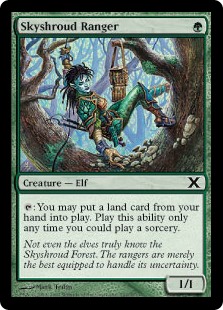Tribal Guide: The Book of Elves
- PDH Home Base

- May 9, 2018
- 7 min read

After being introduced to the format by a close mate, I can still remember, to this day, the excitement of brewing my first PDH deck. As I have grown as a player, this deck has grown with me, slowly perfecting itself, and shaping around the formulating meta that defines PDH today. My elves deck is still my first pick when jumping into any game, and I don't see that changing any time soon.
I still remember why I ended up choosing Elves in the first place. I was playing a lot of EDH at the time, and I could see Tribal had its flaws in a singleton format. I had an opportunity to watch some Legacy players at my LGS (coming from a small town, Legacy players are rather scarce), and I saw elves being played. Aside from the superb game play, the cards themselves caught my eye. The elves, many weren't big money cards, but simple commons. Old commons (and not always as cheap as a common), but a common all the same. What if that magic could be applied to PDH?
To my surprise, there was far more to explore than I could possibly imagine. I have been holding off on this piece for awhile, because I wanted to make sure I did this proper justice, and I think now is the time. After enough games under my belt, and exploring different avenues of a proper elves build, I feel confident that this will deliver where the past two chapters of the Tribal Guide had been lacking. Prepare to explore some new open doors into tribal, right here with Elves!
The Immediate Dangers
With each game, regardless or a win or a loss, I always have a blast playing Elves, and building my board state at a scary rate. However, as someone who has been playing this deck for quite some time, there are weaknesses. Throughout my experience, I have identified three particular areas of weakness.
1) "Elves are vulnerable to creatures with flying." This flaw may be less about elves, and more
about the format itself, as I have discussed many times before. However, here is where this
deck seems to be taken down most often.
2) "Green has such little card draw." Ramping to the point of cast high cost spells is not the
problem with elves. The issue is keeping your hand full. This is nothing new for green, but does
present a major issue with playing mono-green.
3) "Elves are quite small creatures." Elves alone will not act as your most aggressive hitters,
without heavy assistance and deck tailoring. Elves give so much utility that this is fine, if
addressed properly, by adjusting the higher end of the curve. However, unlike goblins, we want
our elves to stay on the battlefield, and not necessarily be chump blockers. (As we dive into
staple commons, you will see why).
When designing an Elves deck, these are the three areas that absolutely must be considered. If not, then you will find yourself falling flat too often, despite consistent strong starts to most games. Adjust for these elements, and you deck will operate much smoother.
It is fair to assume that simply "addressing all three issues" isn't quite as simple as saying it. Some commanders and deck strategies will be more helpful in one area than others, with no perfect balance. However, it is still possible to optimize your build, regardless of your choice of commander and deck direction.
The Commanders
Picking the best commander for your Elves build can be a bit overwhelming, as there are so many options, and directions that may be embraced. The first I will discuss are the multicolored options that will serve several strategies well.
The immediate benefit with using either of these commanders is the access to card draw. Black has access to destroy spells, as blue has bounce and counter spells. These commanders also both bring a strategy of their own. I personally have a special appreciation for Shaman of the Pack, as this is my personal elves commander. A special piece of the strategy here, this is a commander that is worth recasting, despite the tax. Feel free to equip and attack, as there is something to gain regardless. Zameck Guildmage has value as a Simic commander overall, but it being an Elf stays to theme, as well as serves other elf creatures, as we shall see later on. With the combined ability of strengthening creatures, and card draw, this is not a weak choice.
Our remaining choices, none of which are a weak choice, will be mono green choices, both Elf and Non-Elf. Several strategies are focused on Voltron, token generating, or a bit of shaping your own hand. We will need to still keep in mind the weaknesses when building around any of these, but at this point, it is simply a matter of what suits you best.
If interested in turning your commander into your primary weapon, any of these commanders will do nicely. Jagged-Scar Archers will help with dealing with flying threats,while Heedless One will have a better chance of breaking through chump walls. The one danger to this strategy comes down to burn spells that tend to appear in most red decks, such as Electrickery, or Blazing Volley.
In the case that building a token styled deck will be of interest to you, these three will be your best choice. Llanowar Mentor will allow you to ramp quickly, giving you an opportunity to play very large creatures early on in the game. Imperious Perfect will strengthen your army, as well as make them resistant against the above mentioned red spells. Wolf-Skull Shaman requires no additional effort to
pump out tokens, but has the risk of functioning too slow. None are perfect, but none are weak either.

As you will see below, there are a wide variety of very powerful elves, for very special circumstances. Tutoring is not something that will appear in this format often, so an opportunity to do so with Elvish Harbinger is a treat. There are several ways to bounce this back to your hand with mono green, so this process can be repeated. However, there is always the danger of being milled. It is a less common approach in PDH, as there is such a high level of graveyard utility, but if you are not drawing that creature immediately, this tutor engine will be quite slow, predictable, and will delay card draw.
Each elf commander has its own drawbacks, but will deliver all the same in its own right. With such variety, it is also worth discussing what other options exist. There are two commanders certainly worth considering. The first, Kithkin Mourncaller will help with card draw when your board clears up, but Wirewood Symbiote is a real treat. With so many elves with ETB triggers, the ability to return and recast elves is absolutely fantastic.
The Rest of the 99
There are so many elves, but depending on your design, some will work better than others. However, there are some that should be included regardless. As discussed above, ETB triggers will be a major asset with elves, and it will be essential to include the following below.
Earlier above when discussing Elvish Harbinger, I had mentioned that there would be targets for given situations. One of the most powerful elf engines at your disposal will be Lys Alana Huntmaster. allowing you to keep your board full. Where Elvish Visionary and Fierce Empath give utility as they enter, the others like Elvish Vanguard, Essence Warden, and Ivy Lane Denizen will synergize.
When building up our army of elves, one of the most prominent reasons for wanting them to stay on the battlefield comes down to these three creatures above. Priest of Titania will help ramp in any situation, while Timberwatch Elf will create a giant for a turn. If your side of the battlefield is maintained, Wellwisher will become out of control, and give you a tremendous advantage.
To fill in the spaces of the 99, bring in creatures that serve you, until you can play the larger weapons. There are plenty of ramping tools like Arbor Elf and Skyshroud Ranger, or several creatures equipped to handle flying creatures. Copperhorn Scout will serve as a way for you to not be left wide open, and when possible, re-tap creatures like Wellwisher during a second main.
The above show all necessary elves, given any build. It doesn't matter what you do, you need the above. Below, I will lay out several other permanents to fill in the gaps and weak points of the deck.
There a few necessary enchantments, but these will do a lot for you. Once again, you are looking to flood the board, and be protected from flying creatures. The above three will help with ramping, creature generating, and flying protection.
Observing the above 6 spells, they may appear to be a tad mixed, but it important to consider of the drawbacks to playing this deck. Card draw is incredibly weak, and this must be taken into account. This is where "Cycling" comes into play. If we cannot draw, we can at least thin out our deck, and remove unnecessary tools from our hand.
With that being said, these tools aren't necessarily only good for cycling. In the case of Greater Sandwurm, once you have the mana to cast larger creatures, this will be a great weapon for breaking through defenses. This also applies for Krosan Tusker. In the event your board is cleared, and you're running out of gas, Repopulate will give you more value to draw from your deck. Snake Umbra, a card I would highly recommend for any green deck, should be an auto include, especially with creatures like Timberwatch Elf at our disposal.
For the past several years, I have thoroughly enjoyed playing this deck, and tweaking it as new sets emerge. Elves contain so much power, and give a great game, for beginners and returning folks. Feel free to take a look at how I have personally approached tribal elves, and see what new ideas come to your mind.
Share with me your elf builds, and let me know what cards you utilize most in your game play. I look forward to seeing your brews, and am eager to bring you the next chapter soon. Prepare for the Tribal Guide, "The Book of Zombies," coming in the following weeks!
-Kyle
@PDH_Homebase








































































Comments